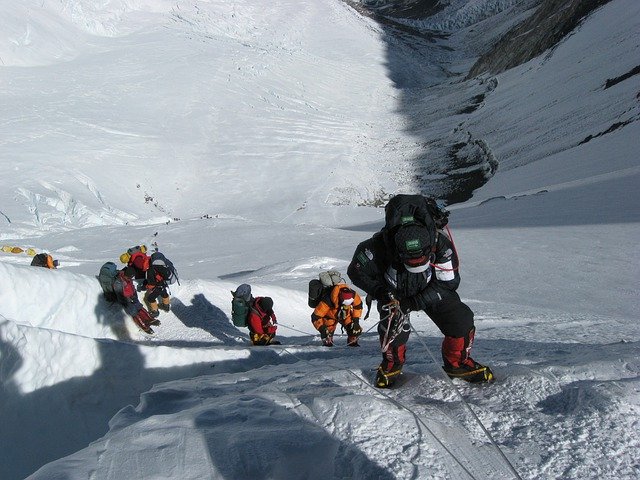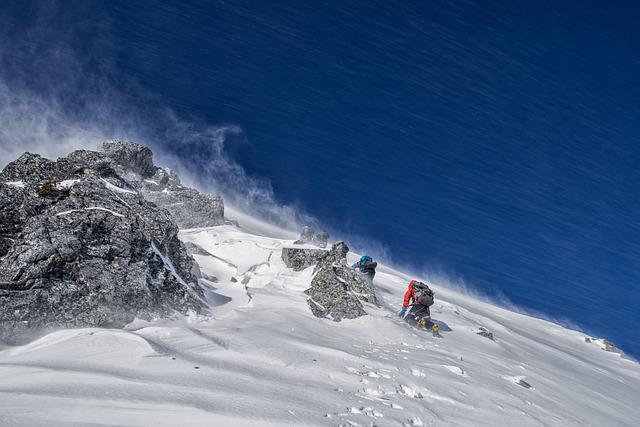Once a sacred, untouched mountain range – today a mass tourism destination. Mount Everest has long ceased to be an insider’s tip for extreme mountaineers. Rather, it has rapidly developed into a dispatch machine in the past few decades that brings people to the summit every day. Much to the suffering of the Sherpa and the women and children who are increasingly losing their husbands due to the dangerous tours at 8,000 meters. How has it gotten this far?

SCENERY OF MADNESS ON MOUNT EVEREST
Several hundred people wait at the foot of Mount Everest. The tour guides from the mountains, also called Sherpas, survey the mountain and the tourists around them. They check the equipment one last time. At Station 4, the last stop on the way to the summit, the madness is palpable. Wealthy climbers with top-of-the-line gear prepare themselves before setting off and can hardly wait for the adventure to begin. Then the rocky path to the summit is before them. Walking single file and slowly ascending, the Sherpas escort their tourists to the top. The path is more arduous than many had imagined. Over and over again, people collapse and have to be taken away by the Sherpas or supplied with oxygen bottles. Those who make it to the top experience a few seconds of blissful views, followed by a rocky, unstable descent and a march that literally involves walking over dead bodies. Then the adventure is over for the tourists. It’s off to lower stations 3, 2 and 1 for acclimatization and then they are on their way home. What is a unique, dangerous adventure for the tourists is the everyday life for the Sherpas. A cruel daily routine for the recreational amusement of people from all over the world. The Sherpas have a good reputation, and earn well. But the job and the supposed fame has a stale, perilous aftertaste.
WHERE OTHERS FIND WAYS, SOME HAVE TO BUILD THEM WITH GREAT EFFORT
What tourists especially do not see: Sherpas are the ones who put in the grueling work to build the treacherous paths. They stretch orientation cords and level paths. They ram poles into the hard, frozen ground. Depending on the time of year, the mountain is unforgiving. In sub-zero temperatures, with little oxygen and unprotected, they do the groundwork for which no thanks are given. They risk their lives for the safety of others. Time and again Sherpas fall, are hit by an avalanche or ice storm, and suffer fatal accidents. If someone falls, they will die almost instantly. But the worst part is that they can’t even be rescued. At these heights, it is an immeasurable effort for aircrafts of any kind to pull the people out of the icy depths. So it happens every year that the lost Sherpas are not honored for their work and remembered by loved ones at a funeral, but remain trapped in the ice masses. They are left behind because there is no other option to help them. Also left behind are the women who have lost their husbands and children who have lost their fathers. The women often receive compensation from the travel agencies that run these tours. But this is not enough for a lifetime; it is a small drop in the bucket of bitterness.
THE ASCENT ITSELF: A TRAUMATIZING TORTURE

Who thinks to themselves, ‘With the preparations it is done’ is sadly mistaken. The Sherpas, who have already paved the way, made supports, and tightened ropes now have to climb the mountain again to bring the tourists safely to the summit and back again. It is a difficult path to get all the way there. Since the tourists are mostly inexperienced climbers, the Sherpas have to carry the equipment on their backs. At an altitude of over 8,400 meters, and with an icy wind in their face that chills them to the bone. On the way to the summit, people slip repeatedly, and have to be caught and even held. It is necessary to take breaks, though these pauses can escalate into a life-threatening danger if they are exceeded.
At 8,000 meters, every second of oxygen counts. It can determine whether you make it or not. Or whether you start hallucinating. Very often it happens that tourists suffer from oxygen deprivation to such an extent that they can no longer distinguish reality from fiction or are out of their minds. Sherpas tell of some traumatic stories. For example, tourists have tried several times to kill Sherpas at the summit with an axe because they did not want the guides to be on the mountain before them. As the Sherpa is responsible for everyone’s safety, tourists are unable to ascend the mountain before the Sherpa. Others tell of being forced to perform ‘daredevil feats’ so that the tourists have something to report or photograph. In the process, chunks of ice break off again and again. Avalanches are also triggered not only by the Sherpas but by the masses of tourists and nothing but the struggle for naked survival begins for all involved.
NO THANKS AND NO HELP
After the descent, there is usually no word of thanks or appreciation waiting for the Sherpas. They arrive at station 4, exhausted from the tours. They are often injured because they had to prevent even worse accidents from happening, were threatened, or had to carry the tourists almost half of the way. Ribs are bruised from catching them, legs are injured, or they have an experience they soon won’t forget due to the mental abuse caused by the tourists’ lack of oxygen. But instead of receiving help, they are often left to fend for themselves. Once they are back at home, they tend to their wounds and then plunge back into the misery again in the days to come. The wages seem to be relatively good by local standards. Nevertheless, at any second there is the possibility of dying and perishing from a tour, because there is no help. It almost seems like the mountain is fighting back. One can hardly blame it – these overpriced tours are hard to beat when it comes to ecological and human ruthlessness. But the sighting of the earth’s curvature at 8,000 meters seems to have become a new kind of status symbol on the Tibetan plateau.
SHERPAS WITH WESTERN IDENTITY – OVERPAINTING OF CULTURE
Originally, the Sherpas were not interested in mountaineering at all, until this huge tourism market emerged. So they are forced by (bad) economic situations to do a job that has already cost many lives. And may even take their own. In addition, Mount Everest is considered sacred ground for the Sherpas, guarded by gods. The crowds of tourists, however, do not take this into account. They trample, destroy and show zero respect for the traditions of the mountain people. It seems as if the original identity of the “guides” is painted over by western culture. Many Westerners have an idealized image of the Sherpas: they are supposed to have a strong mind, to be persevering, and to be brave, loyal Buddhists. The workers themselves have been trained for decades and strive to achieve this ideal that the West projects onto them. Their own personalities and even their own culture, with its customs and beliefs, recede into the background. They become what the world imagines them to be: reserved and oriented in the good of the West. You’re supposed to be submissive, say nothing, and do your job, almost as if you were prisoners of labor in your own country. It is heartbreaking to think of your own identity being taken away for the benefit of others.
MOUNT EVEREST WITH ETHICS IN MIND
For a long time, the Sherpas have been fighting back and struggling for better working conditions. However, just a fraction of the revenue per season arrives at the Sherpas from the total of 100,000 Euros that remain with the tour operators. Tourism on Mount Everest clearly needs to become more ethical and fair. The Sherpas deserve better conditions, health insurance, and better compensation. And most importantly, they want to be valued for what they do. A climb is hard work. In addition, locals want only experienced climbers to be able to climb the mountain in the future. This is because inexperienced people not only put themselves in danger, but also those who help them. An experienced climber does not expose himself to certain dangers in the first place because he can judge exactly how to handle the situation. This also protects the Sherpas and makes their work easier.
Educational work can certainly make an important contribution to improving the conditions for the Sherpas. Sherpas die with such regularity that it has become routine. The deaths of the Sherpas are always swept under the rug in the course of the shiny adventures, as if their lives are worth less than those of the tourists. But they aren’t. Every life is precious. And not talking about it just because it might hurt the money machine doesn’t do the workers justice. Educating and talking about it not only helps the families, but also helps improve working conditions.
SHERPAS EXPLAINED:
Sherpas were the names given to the inhabitants in eastern Nepal. Today, however, all those who work as guides are called so, even if they come from another region. The Sherpa (Scherpa; German roughly “Ostvolk”, Tibetan ཤར་པ Wylie shar pa) are a people who migrated to the Central and Southern Himalayas 300 to 400 years ago.
Sources:
https://de.wikipedia.org/wiki/Sherpa
https://sz-magazin.sueddeutsche.de/neue-fotografie/mount-everest-sherpas-ausbeutung-87171https://sz-magazin.sueddeutsche.de/neue-fotografie/mount-everest-sherpas-ausbeutung-87171 https://www.nationalgeographic.de/reise-und-abenteuer/2017/06/sherpas-die-unsichtbaren-des-everest https://www.fluter.de/ein-berg-voller-probleme
Translated by Emily Schifferer
#exploitation #danger #sherpas #working conditions #againsthumantrafficking #gegenmenschenhandel #endexploitation #endtrafficking #hopeforthefuture
